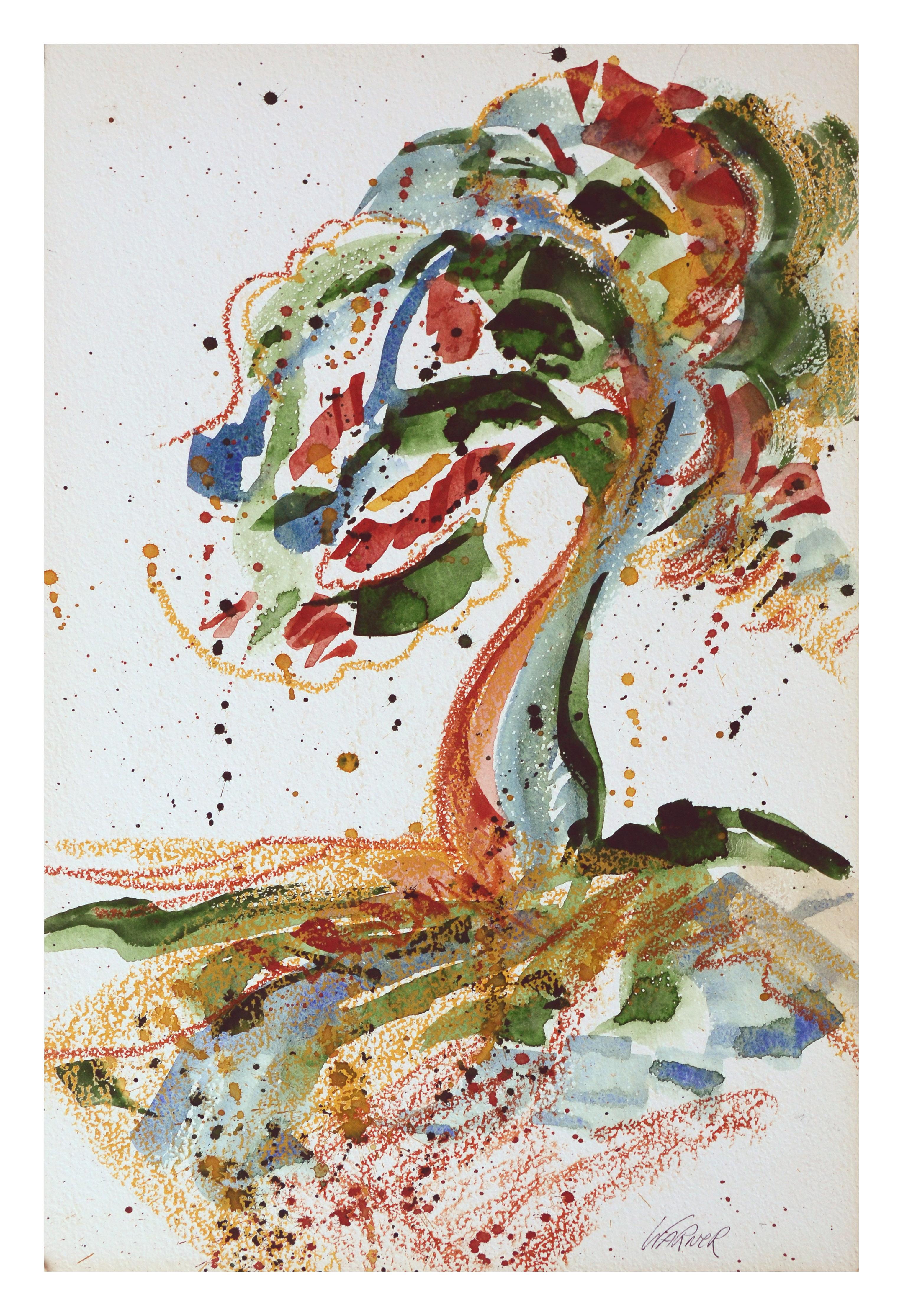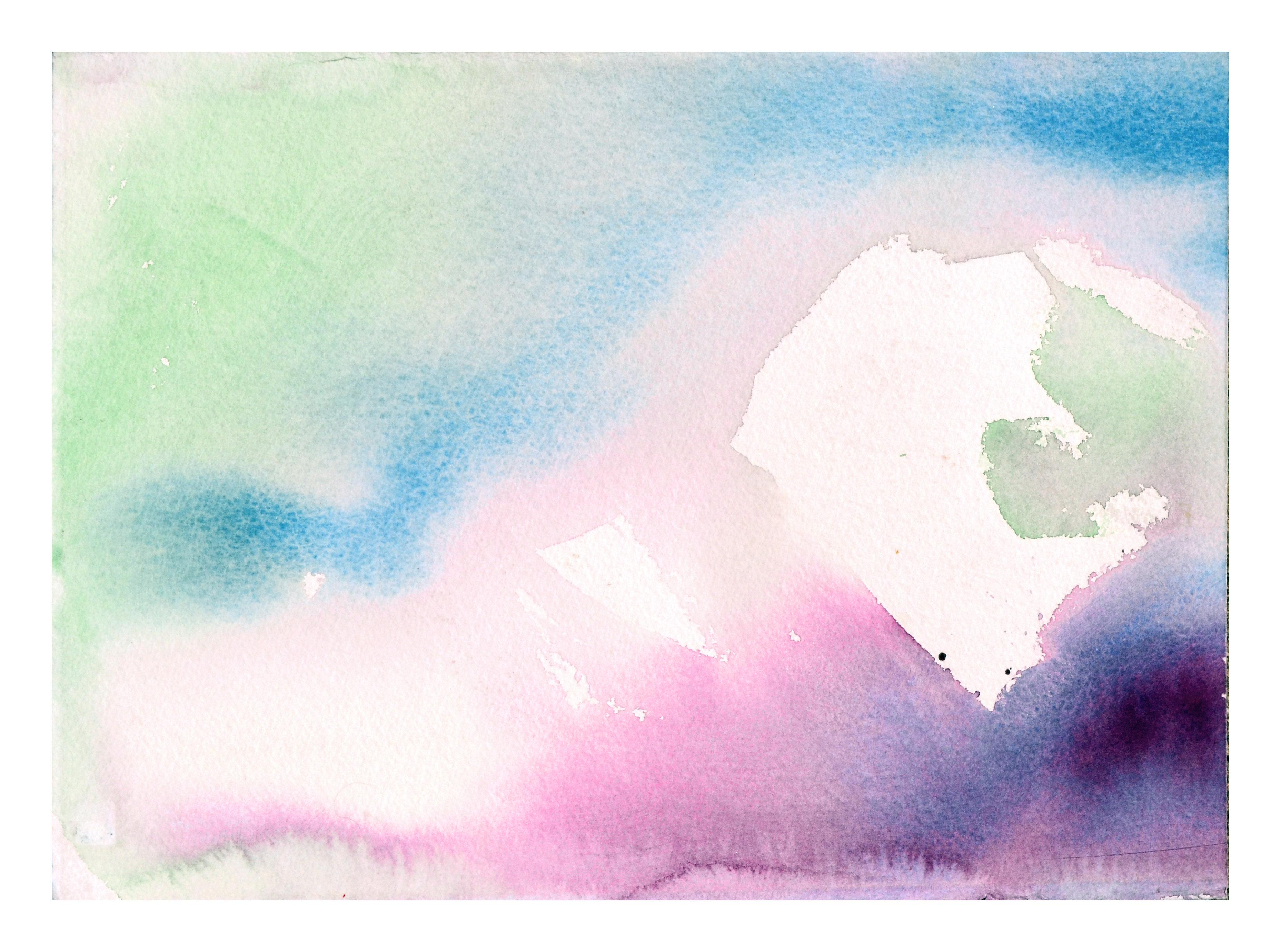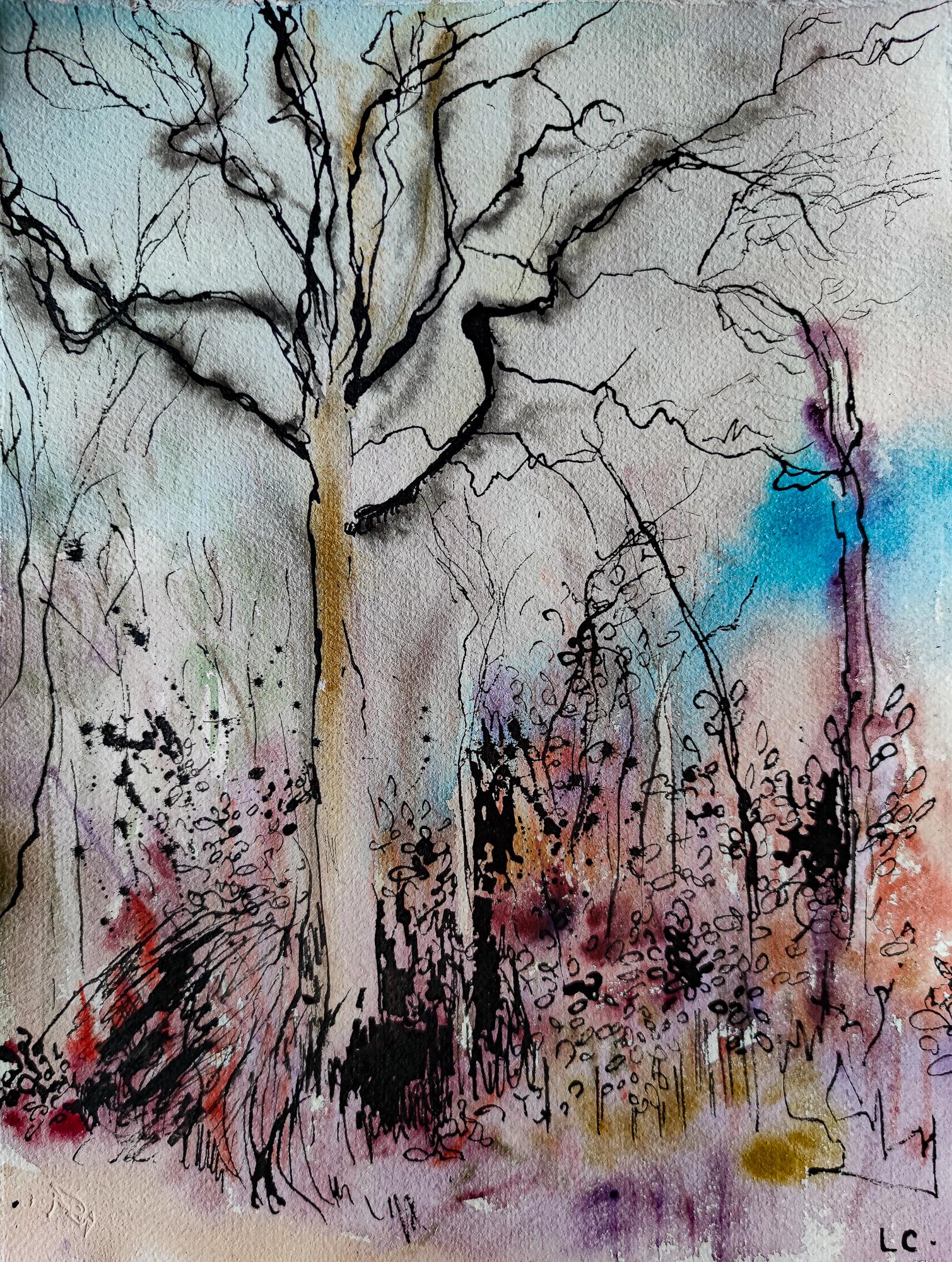Want more images or videos?
Request additional images or videos from the seller
1 of 11
John von WichtUntitled Abstractionc. 1960's
c. 1960's
About the Item
Untitled Abstrraction
Gouache, watercolor and pigments on paper, c. 1960
Signed lower right in pencil (see photo)
Image: 17 x 22 inches
Sheet: 25 1/4 x 29 3/4 inches
Frame: 25 1/4 x 29 3/4 inches
Archival framing with OP3 Acrylic
"John von Wicht was highly trained in fine and applied arts in his native Germany before he immigrated to the United States in 1923. When he was seventeen he apprenticed in a painting and decorating shop, and spent his spare time drawing from nature. He began painting in oil about 1908, and soon thereafter sold his first canvas. Encouraged that her son would have a future as an artist, von Wicht’s mother sent him to the advanced private school of the Grand Duke of Hesse, where the professors encouraged students to draw plants and flowers to learn about organic growth, shape and proportion. “I remember the Professor speaking of circular movements, of space between forms and of Equilibrium,” von Wicht later recalled.(1) The students also studied ancient art, Chinese and Japanese calligraphy, as well as Mathias Grünewald, Albrecht Dürer, Martin Schongauer, Hans Memling, and other German masters whose work was in local collections. Von Wicht subsequently studied printing methods at the Royal School for Fine and Applied Arts in Berlin, but said he skipped class frequently to visit exhibitions of the newest painting — van Gogh, Cézanne, Munch, Gauguin, Kandinsky, and Franz Marc.
Wounded and partially paralyzed in the trenches during World War I, von Wicht spent several years recovering, doing book design and illustration work, and looking at art. It was during this recuperation that he discovered Mondrian and Malevich. In 1923, with inflation devastating the German economy, he immigrated to the United States. In New York, his early training served him well. He worked for two years with a lithography company, then joined a firm making stained glass and mosaics. He learned to use symbols rather than naturalistic motifs, and explored both geometry and dense color in abstract paintings such as the Untitled gouache of about 1938, and in murals for radio station WNYC and the New York World’s Fair.
Von Wicht had his first solo show, of mural designs, at the Architect’s Building in 1936. It was followed, in 1939, by an exhibition of his paintings at Theodor A. Kohn Gallery. The show at Kohn was well received by the New York press, and the following year he exhibited at the Whitney Museum of American Art. This exposure cemented von Wicht’s reputation as an abstract painter. Throughout the 1940s, 1950s, and 1960s, he exhibited frequently in solo and group exhibitions in New York and around the country. He was invited to join the American Abstract Artists and the Federation of Modern Painters and Sculptors.
During World War II, von Wicht served as captain of a supply barge ferrying food to army transport ships in New York harbor; after the war he continued to command a supply scow. Harbor themes began to appear in his abstractions, and during the 1950s his sensuously colored geometric abstractions gave way to loose, expressionistic forms. In 1954 von Wicht received the first of twelve annual residencies at the MacDowell Colony in New Hampshire. The spacious studio and contact with other artists at the MacDowell Colony had an important impact on his work. In his exhibition at Passedoit Gallery that year, he exhibited paintings with nautical motifs in which the Cubist device of interlocking and overlapping planes was paramount. But von Wicht also began relating his work to music created by the composers he had met at MacDowell. Although his work was well received from the time of his first exhibition, critics attributed the expanded sense of space, brilliant color, and vigorous handling of paint surfaces in his new work to the experience of living away from the city. By the time he died, in 1970, von Wicht had received international acclaim."
Courtesy Smithsonian American Art Museum
- Creator:John von Wicht (1888-1970, American)
- Creation Year:c. 1960's
- Dimensions:Height: 17 in (43.18 cm)Width: 22 in (55.88 cm)
- Medium:
- Movement & Style:
- Period:
- Condition:Soft crease in upper right corner, threw a portion of the image, but not objectionable. Framed with conservation clear acrylic.
- Gallery Location:Fairlawn, OH
- Reference Number:
About the Seller
5.0
Recognized Seller
These prestigious sellers are industry leaders and represent the highest echelon for item quality and design.
Platinum Seller
These expertly vetted sellers are 1stDibs' most experienced sellers and are rated highest by our customers.
Established in 1978
1stDibs seller since 2013
716 sales on 1stDibs
Typical response time: 1 hour
Associations
International Fine Print Dealers Association
- ShippingRetrieving quote...Ships From: Fairlawn, OH
- Return PolicyA return for this item may be initiated within 10 days of delivery.
More From This SellerView All
- UntitledBy Leon KellyLocated in Fairlawn, OHUntitled Graphite on paper, 1930 Signed and dated upper right (see photo) Exhibited: Francis Nauman, Leon Kelly: Draftsman Extraordinaire, New York, April 4 - May 23, 2014. (label) C...Category
1920s Abstract Expressionist Abstract Drawings and Watercolors
MaterialsPencil
- untitledBy Virginia DehnLocated in Fairlawn, OHUnsigned Authenticated verso by the artist's nephew, Andrew Lowe Provenance: Estate of the ArtistCategory
Mid-20th Century Abstract Expressionist Abstract Drawings and Watercolors
MaterialsPastel
- Untitled (Abstraction)By Rolph ScarlettLocated in Fairlawn, OHUntitled (Abstraction) Ink on textured paper, c. 1958 Signed lower right: Scarlett Note: A rare mid to late 1950s example of the artist's abstract expressionist style. Provenance: Es...Category
1950s Abstract Expressionist Abstract Drawings and Watercolors
MaterialsInk
- UntitledBy Dorothy HellerLocated in Fairlawn, OHUntitled Watercolor on paper, 1990 Signed lower left corner Provenance: Gift of the Artist to one of hr patrons Distinguished Midwest Private Collection Conditi...Category
1990s Abstract Abstract Drawings and Watercolors
MaterialsWatercolor
- Nickle DrawingBy Dorothy DehnerLocated in Fairlawn, OHNickle Drawing Ink and watercolor on laid paper, 1982 Signed and dated lower right in ink The title references a comment that her husband, David Smith, made regarding her drawings. He said that they were only worth a nickle and the name stuck even thought her works are highly prized. The dating of this work reflects the date inscribed on the watercolor. The style and black ink lines with dots terminating the line is a compositional device the artist used in the 1950's. Condition: Very fine/excellent 4 old hinge residue in the corners verso from previous matting Sheet/image size: 7 1/2 x 4 7/8 inches Dorothy Dehner (1901-1994) Painter, sculptor, art writer, and poet, Dorothy Dehner explored abstraction, cubism, realism and surrealism during her artistic journey. Early in her career she was known for painting and for large-cast metal sculptures, but in the 1950s and 1960s, turned increasingly to wood cut into hard-edge geometric shapes. From 1950, she lived primarily in New York City. Dorothy Dehner was born in 1901 in Cleveland, Ohio, but, as a teenager in 1916, moved to Pasadena, California when her parents died. Her artistic interests were initially in acting. She majored in drama at UCLA for the school year of 1922-1923, then moved to New York City to study acting at the American Academy of Dramatic Art. After travel to Europe in France, Italy and Switzerland in 1925, where she saw Cubist and Fauve paintings as well as the great art of the ages, Dehner entered the Art Students League to study sculpture, but switched to painting because she felt the former was bound in academic formula. She studied drawing with Kimon Nicolaides and painting with Kenneth Hayes Miller. In 1929, she studied painting with Jan Matulka. Meeting artist John Graham in that year, he introduced her to Milton Avery, Stuart Davis and Arshile Gorky. She would also take art courses years later at Skidmore College in 1951. Dehner married sculptor David Smith in 1927. She was evidently very helpful in his artistic growth, but friction would develop because Smith allegedly saw his wife as artistic competition. Although she painted and drew Cubist and Surrealist works during their marriage, and realistic ones of life on their Bolton Landing, New York farm during the period 1941 to 1944, Dehner would essentially put her exhibition life on hold until their divorce in 1952. Meanwhile, they traveled to Europe in 1935. She later wrote about Smith, as well as painter John Graham and Jan Matulka, her teacher. Although she had shown in the 1946 Audubon Artists exhibition, winning first prize in drawing, and in the Whitney Annual of 1951, it was the year of her divorce, 1952, that Dehner had her first one-person exhibition at the Rose Fried Gallery...Category
1980s Abstract Abstract Drawings and Watercolors
MaterialsWatercolor
- Black and White CatBy Sam SpanierLocated in Fairlawn, OHBlack and White Cat Ink and watercolor on paper, c. 1970 Unsigned Provenance: Estate of the artist (Estate No. 737) Condition: Excellent Image/Sheet size: 4 3/4 x 6 1/4 inches Sam Spanier (1925-2008) Born in Brooklyn New York, Sam Spanier studied painting with Hans Hofmann (1949–50) and also at the Taos Valley Art School (1951). His formative years as a working artist were spent in Paris (1951–52), where he also became involved with the work of G. I. Gurdjieff, through his disciple, Mme. Jeanne de Salzmann. By 1953, Spanier’s work had already begun to meet with critical acclaim. That year, he had his first solo gallery show, and was selected by Milton Avery and Hans Hofmann to receive the prestigious Lorian Fund Award. His second solo exhibition, in 1955, was curated by renowned museum director, Gordon Washburn. Spanier’s early work was reviewed by Dore Ashton, Donald Judd, Fairfield Porter, Stuart Preston, and Irving Sandler, among other significant critics of the period. Spanier’s spiritual path increasingly became the central focus of both his life and his art. In 1960, he was introduced to the teachings of Sri Aurobindo, which led to visits to the Sri Aurobindo Ashram in Pondicherry, India, in 1962 and 1964, during which he was inspired to leave New York City and found Matagiri (in 1968)—a spiritual center in Woodstock, New York—with his lifelong partner, Eric Hughes. The work he embarked upon there bifurcates his life as an artist, separating him from New York’s art world, and radically altering the trajectory of his career. From that point forward, it would be difficult, perhaps impossible, to consider his artistic endeavor apart from the life of dedication he had undertaken, and to which he remained committed. As early as 1954, Dore Ashton had recognized in Sam Spanier a “haptic visionary;” in 1960, Irving Sandler wrote that the people in Spanier’s paintings “seem to have witnessed some transfiguring event.” In his later paintings—usually worked in oil pastel on panel or paper—made during intermittent creative periods, from the mid-1970s to the final years of his life, the artist’s inner life remains always apparent in his subject matter; and from the portraits and abstract Buddha-like figures and heads, to the fantasy landscapes, the paintings are redolent with a rich intensity of color and light that can only be described as inspired. Sam Spanier’s works are in the collections of the Historical Society of Woodstock Museum, and the Woodstock Artists Association & Museum. He received the Woodstock Artists Association Lifetime Achievement Award in 2007. Selected Solo Exhibitions: Urban Gallery, New York (1954, 1955, 1956); Wittenborn Gallery, New York (1958); Gallery Mayer, New York (1958, 1959, 1960); Unison Gallery, New Paltz (1986, 1995, 2009); Limner Gallery, New York (1988); Fletcher Gallery, Woodstock, New York (1999). Selected Group Exhibitions: Salon des Comparaisons, Musée d’Art Moderne, Paris, France (1952); October Exhibition of Oil Paintings, New York City Center Gallery, New York (1954); Salon de Mai, Musée d’Art moderne de la ville de Paris, Centre Culturel de Saint-Germain-en-Laye, Paris, France (1954); Carnegie International, Carnegie Institute, Pittsburgh, Pennsylvania (1955); Les Plus Mauvais Tableaux, Galerie Prismes, Paris (1955); Première Exposition Internationale de l’Art Plastique Contemporain, Musée des Beaux-Arts de la Ville de Paris (1956); Recent Paintings USA: The Figure, The Museum of Modern Art (1960); Winter’s Work, Woodstock Artists Association, Woodstock, New York (1985); Juried Group Show, Woodstock Artists Association, Woodstock, New York (1986); Woodstock Artists, Self-Portraits, Historical Society of Woodstock Museum, Woodstock, New York (1988); Portraits, Albert Shahinian Fine Art, Poughkeepsie, New York (2003); The World We Live In, Upstate Art, Phoenicia, New York (2003); Show of Heads, Limner Gallery, Phoenicia, New York (2004). Selected Writings on the Artist: Dore Ashton, “Sam Spanier,” Art Digest (May 1, 1954) and “Sam Spanier,” The New York Times (March 16, 1960); Cassia Berman, “Sam Spanier: A Divine Calling,” Woodstock Times (February 7, 2008); Lawrence Campbell, “Sam Spanier: Exhibition of Paintings at Urban Gallery,” Art News...Category
1970s Abstract Abstract Drawings and Watercolors
MaterialsInk, Watercolor
You May Also Like
- Blue Tides AbstractBy Doris WarnerLocated in Soquel, CAAbstract watercolor and pastel multimedia painting of blue tides with brown, orange, and yellow between by Doris Ann Warner (American, 1925-2010). Signed "Warner" lower right. Unfram...Category
1970s Abstract Expressionist Abstract Drawings and Watercolors
MaterialsPaper, Watercolor
- Colorful Abstracted TreeBy Doris WarnerLocated in Soquel, CAColorful abstracted tree with hues of red, blue, and green by Doris Ann Warner (American, 1925-2010). Signed "Warner" lower right. Unframed. Doris Ann Warner began as an Abstract Ex...Category
1970s Abstract Expressionist Abstract Drawings and Watercolors
MaterialsPaper, Watercolor
- Cosmic Lavender Abstract WatercolorBy Les AndersonLocated in Soquel, CAA softly colored watercolor abstract in lavender, blue and green by Les (Leslie Luverne) Anderson (American, 1928-2009). Unsigned. From the estate of Les Anderson in Monterey, Califo...Category
1980s Abstract Expressionist Abstract Drawings and Watercolors
MaterialsPaper, Watercolor
- Green AbstractBy Doris WarnerLocated in Soquel, CADynamic abstract with green and black swirling together by Doris Ann Warner (American, 1925-2010). Signed "Warner" lower left. Unframed. Image size, 9"H x 12"W. Purchased from the es...Category
1970s Abstract Expressionist Abstract Drawings and Watercolors
MaterialsPaper, Watercolor
- Dormant SapLocated in THOMERY, FR"Dormant Sap" portrays the essence of winter's embrace, where the tree's bare branches stand as silent sentinels against the pale backdrop of a frost-kissed landscape. Executed with ...Category
21st Century and Contemporary Abstract Expressionist Landscape Drawings ...
MaterialsInk, Watercolor
- Blue & Yellow Abstract WatercolorBy Les AndersonLocated in Soquel, CABlue & yellow abstract watercolor by Les (Leslie Luverne) Anderson (American, 1928-2009). From the estate of Les Anderson in Monterey, California. Signed on verso and unframed. Image...Category
1980s Abstract Expressionist Abstract Drawings and Watercolors
MaterialsPaper, Watercolor
Recently Viewed
View AllMore Ways To Browse
Modern Abstraction
Color Photo Mosaic
Colony New York
German Expressionists Drawings
Vintage 1960s Food
Vintage Japanese Watercolor
Vintage Japanese Watercolor Paintings
Japanese Retro Watercolor
Han Solo
Van Gogh Drawings
Vintage New Radio
Japanese Vintage Music
Vintage Plant Drawings
Grand Army
Von Hans
1960s Geometric Drawing
Grand Duke
Vintage Army Glasses





